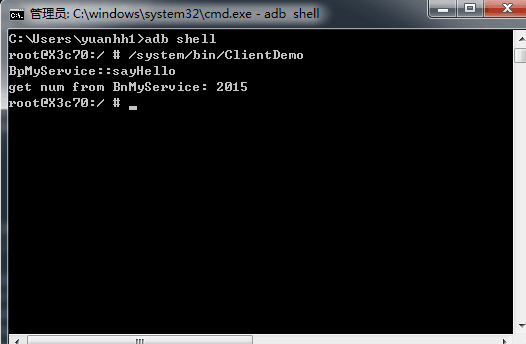Binder系列8—如何使用Binder
作者:互联网
copy from http://gityuan.com/2015/11/22/binder-use/
自定义binder架构的 client/ server组件
一、Native层Binder
源码结构:
- ClientDemo.cpp: 客户端程序
- ServerDemo.cpp:服务端程序
- IMyService.h:自定义的MyService服务的头文件
- IMyService.cpp:自定义的MyService服务
- Android.mk:源码build文件
1.1 服务端
#include "IMyService.h"
int main() {
//获取service manager引用
sp < IServiceManager > sm = defaultServiceManager();
//注册名为"service.myservice"的服务到service manager
sm->addService(String16("service.myservice"), new BnMyService());
ProcessState::self()->startThreadPool(); //启动线程池
IPCThreadState::self()->joinThreadPool(); //把主线程加入线程池
return 0;
}
将名为”service.myservice”的BnMyService服务添加到ServiceManager,并启动服务
1.2 客户端
#include "IMyService.h"
int main() {
//获取service manager引用
sp < IServiceManager > sm = defaultServiceManager();
//获取名为"service.myservice"的binder接口
sp < IBinder > binder = sm->getService(String16("service.myservice"));
//将biner对象转换为强引用类型的IMyService
sp<IMyService> cs = interface_cast < IMyService > (binder);
//利用binder引用调用远程sayHello()方法
cs->sayHello();
return 0;
}
获取名为”service.myservice”的服务,再进行类型,最后调用远程方法sayHello()
1.3 创建MyService
(1)IMyService.h
namespace android
{
class IMyService : public IInterface
{
public:
DECLARE_META_INTERFACE(MyService); //使用宏,申明MyService
virtual void sayHello()=0; //定义方法
};
//定义命令字段
enum
{
HELLO = 1,
};
//申明客户端BpMyService
class BpMyService: public BpInterface<IMyService> {
public:
BpMyService(const sp<IBinder>& impl);
virtual void sayHello();
};
//申明服务端BnMyService
class BnMyService: public BnInterface<IMyService> {
public:
virtual status_t onTransact(uint32_t code, const Parcel& data, Parcel* reply, uint32_t flags = 0);
virtual void sayHello();
};
}
主要功能:
- 申明IMyService
- 申明BpMyService(Binder客户端)
- 申明BnMyService(Binder的服务端)
(2)IMyService.cpp
#include "IMyService.h"
namespace android
{
//使用宏,完成MyService定义
IMPLEMENT_META_INTERFACE(MyService, "android.demo.IMyService");
//客户端
BpMyService::BpMyService(const sp<IBinder>& impl) :
BpInterface<IMyService>(impl) {
}
// 实现客户端sayHello方法
void BpMyService::sayHello() {
printf("BpMyService::sayHello\n");
Parcel data, reply;
data.writeInterfaceToken(IMyService::getInterfaceDescriptor());
remote()->transact(HELLO, data, &reply);
printf("get num from BnMyService: %d\n", reply.readInt32());
}
//服务端,接收远程消息,处理onTransact方法
status_t BnMyService::onTransact(uint_t code, const Parcel& data,
Parcel* reply, uint32_t flags) {
switch (code) {
case HELLO: { //收到HELLO命令的处理流程
printf("BnMyService:: got the client hello\n");
CHECK_INTERFACE(IMyService, data, reply);
sayHello();
reply->writeInt32(2015);
return NO_ERROR;
}
break;
default:
break;
}
return NO_ERROR;
}
// 实现服务端sayHello方法
void BnMyService::sayHello() {
printf("BnMyService::sayHello\n");
};
}
1.4 原理图

1.5 运行
(1)编译生成 利用Android.mk编译上述代码,在Android的源码中,通过mm编译后,可生成两个可执行文件ServerDemo,ClientDemo。
(2)执行
首先将这两个ServerDemo,ClientDemo可执行文件push到手机
adb push ServerDemo /system/bin
adb push ClientDemo /system/bin
如果push不成功,那么先执行adb remount,再执行上面的指令;如果还不成功,可能就是权限不够。
如果上述开启成功,通过开启两个窗口运行(一个运行client端,另一个运行server端)
(3)结果
服务端:

客户端:

二、Framework层Binder
源码结构:
Server端
- ServerDemo.java:可执行程序
- IMyService.java: 定义IMyService接口
- MyService.java:定义MyService
Client端
- ClientDemo.java:可执行程序
- IMyService.java: 与Server端完全一致
- MyServiceProxy.java:定义MyServiceProxy
2.1 Server端
(1)ServerDemo.java
可执行程序
public class ServerDemo {
public static void main(String[] args) {
System.out.println("MyService Start");
//准备Looper循环执行
Looper.prepareMainLooper();
//设置为前台优先级
android.os.Process.setThreadPriority(android.os.Process.THREAD_PRIORITY_FOREGROUND);
//注册服务
ServiceManager.addService("MyService", new MyService());
Looper.loop();
}
}
(2)IMyService.java
定义sayHello()方法,DESCRIPTOR属性
public interface IMyService extends IInterface {
static final java.lang.String DESCRIPTOR = "com.gityuan.frameworkBinder.MyServer";
public void sayHello(String str) throws RemoteException ;
static final int TRANSACTION_say = android.os.IBinder.FIRST_CALL_TRANSACTION;
}
(3)MyService.java
public class MyService extends Binder implements IMyService{
public MyService() {
this.attachInterface(this, DESCRIPTOR);
}
@Override
public IBinder asBinder() {
return this;
}
/** 将MyService转换为IMyService接口 **/
public static com.gityuan.frameworkBinder.IMyService asInterface( android.os.IBinder obj) {
if ((obj == null)) {
return null;
}
android.os.IInterface iInterface = obj.queryLocalInterface(DESCRIPTOR);
if (((iInterface != null)&&(iInterface instanceof com.gityuan.frameworkBinder.IMyService))){
return ((com.gityuan.frameworkBinder.IMyService) iInterface);
}
return null;
}
/** 服务端,接收远程消息,处理onTransact方法 **/
@Override
protected boolean onTransact(int code, Parcel data, Parcel reply, int flags) throws RemoteException {
switch (code) {
case INTERFACE_TRANSACTION: {
reply.writeString(DESCRIPTOR);
return true;
}
case TRANSACTION_say: {
data.enforceInterface(DESCRIPTOR);
String str = data.readString();
sayHello(str);
reply.writeNoException();
return true;
}}
return super.onTransact(code, data, reply, flags);
}
/** 自定义sayHello()方法 **/
@Override
public void sayHello(String str) {
System.out.println("MyService:: Hello, " + str);
}
}
2.2 Client端
(1)ClientDemo.java
可执行程序
public class ClientDemo {
public static void main(String[] args) throws RemoteException {
System.out.println("Client start");
IBinder binder = ServiceManager.getService("MyService"); //获取名为"MyService"的服务
IMyService myService = new MyServiceProxy(binder); //创建MyServiceProxy对象
myService.sayHello("binder"); //通过MyServiceProxy对象调用接口的方法
System.out.println("Client end");
}
}
(2)IMyService.java
与Server端的IMyService是一致,基本都是拷贝一份过来。
(3)MyServiceProxy.java
public class MyServiceProxy implements IMyService {
private android.os.IBinder mRemote; //代表BpBinder
public MyServiceProxy(android.os.IBinder remote) {
mRemote = remote;
}
public java.lang.String getInterfaceDescriptor() {
return DESCRIPTOR;
}
/** 自定义的sayHello()方法 **/
@Override
public void sayHello(String str) throws RemoteException {
android.os.Parcel _data = android.os.Parcel.obtain();
android.os.Parcel _reply = android.os.Parcel.obtain();
try {
_data.writeInterfaceToken(DESCRIPTOR);
_data.writeString(str);
mRemote.transact(TRANSACTION_say, _data, _reply, 0);
_reply.readException();
} finally {
_reply.recycle();
_data.recycle();
}
}
@Override
public IBinder asBinder() {
return mRemote;
}
}
2.3 原理图

2.4 运行
首先将ServerDemo,ClientDemo可执行文件,以及ServerDemo.jar,ClientDemo.jar都push到手机
adb push ServerDemo /system/bin
adb push ClientDemo /system/bin
adb push ServerDemo.jar /system/framework
adb push ClientDemo.jar /system/framework
如果push不成功,那么先执行adb remount,再执行上面的指令;如果还不成功,可能就是权限不够。
如果上述开启成功,通过开启两个窗口运行(一个运行client端,另一个运行server端)
结果
服务端:

客户端:

标签:系列,IMyService,MyService,如何,Binder,sayHello,reply,data,public 来源: https://www.cnblogs.com/Oude/p/12363383.html